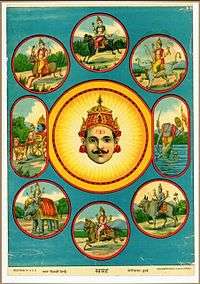Navagraha
Navagraha are nine heavenly bodies (as well as deities) that influence human life on Earth in Hinduism and Hindu astrology. The term is derived from nava (Sanskrit: नव "nine") and graha (Sanskrit: ग्रह "planet, seizing, laying hold of, holding").[2]

Navagraha, a Raja Ravi Varma painting (sun at the center)
Planets, celestial bodies and lunar nodes
The Navagraha are:
Carnatic Music
Muthuswami Dikshitar, a Carnatic music composer from southern India composed the Navagraha Kritis in praise of the nine planets.[3] Each song is a prayer to one of the nine planets. The sahitya (lyrics) of the songs reflect a profound knowledge of the mantra and jyotisha sastras.
See also
Notes
| Wikimedia Commons has media related to Navagraha. |
- Sanskrit-English Dictionary by Monier-Williams, 1899
- "Dikshitar: Navagraha". www.medieval.org. Retrieved 2020-06-12.
This article is issued from Wikipedia. The text is licensed under Creative Commons - Attribution - Sharealike. Additional terms may apply for the media files.
